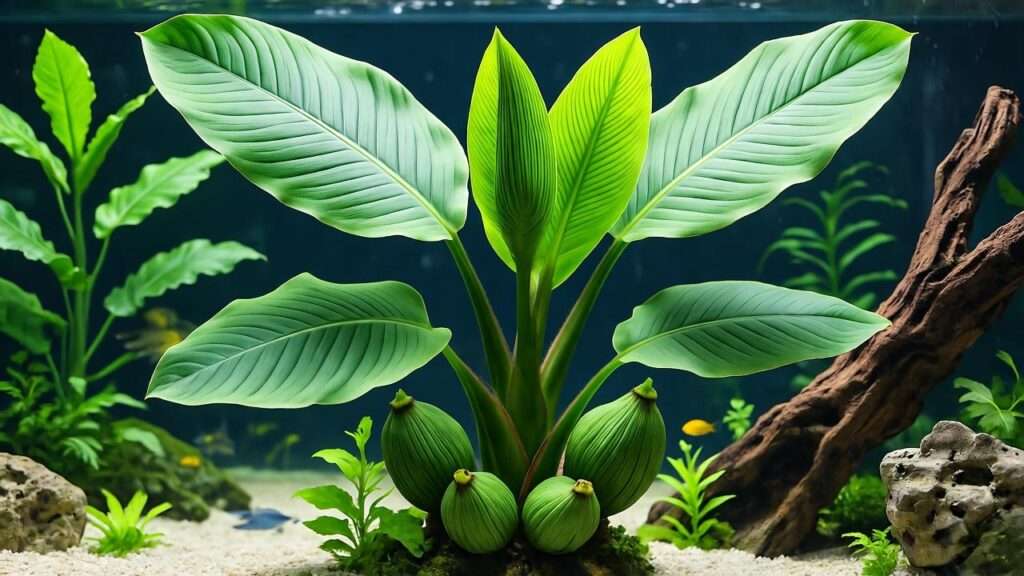Imagine transforming your aquarium into a lush, tropical oasis that captivates the eye and nurtures your fish. The banana plant aquarium is the secret to achieving this vibrant underwater paradise! Known for its quirky banana-like tubers and lush, heart-shaped leaves, the banana plant (Nymphoides aquatica) is a beginner-friendly aquatic plant that adds both beauty and function to your tank. Whether you’re a novice aquarist or a seasoned hobbyist, this guide will equip you with expert-backed, actionable tips to grow a thriving banana plant aquarium. Drawing from years of aquatic plant care experience and insights from aquatic botanists, we’ll cover everything you need to create a stunning, healthy underwater ecosystem. Ready to dive in? Let’s make your tank a masterpiece! 🐟
What Is a Banana Plant Aquarium? 🐠
Understanding Nymphoides Aquatica
The banana plant, scientifically known as Nymphoides aquatica, is a captivating aquatic species native to the wetlands of the southeastern United States. Its nickname comes from its unique, banana-shaped tubers that store nutrients and anchor the plant. These tubers, along with its vibrant green, heart-shaped leaves and occasional delicate white flowers, make it a standout in any aquarium. Unlike terrestrial banana trees, this plant is fully aquatic, thriving submerged or partially floating in freshwater tanks. Its versatility and striking appearance have made it a favorite among aquarists looking to enhance their setups with natural greenery. 🌱
Benefits of Adding Banana Plants to Your Aquarium
Why choose a banana plant for your aquarium? Beyond its aesthetic charm, it offers practical benefits:
- Water Quality: Banana plants absorb excess nutrients, reducing algae growth and boosting oxygenation.
- Fish Habitat: Their broad leaves provide shade and hiding spots, reducing stress for fish like bettas or guppies.
- Low Maintenance: Compared to other aquatic plants, banana plants are hardy and forgiving, perfect for beginners.
- Visual Appeal: The contrast of tubers and floating leaves creates a tropical, jungle-like vibe.
Expert Tip: Banana plants are a fantastic choice for betta fish tanks, mimicking their natural habitat and promoting calm behavior. 🐠
Setting Up Your Banana Plant Aquarium: The Essentials 🛠️
Choosing the Right Tank Environment
To ensure your banana plant thrives, start with the right aquarium setup. Here’s what you need:
- Tank Size: A minimum of 10 gallons is ideal, though larger tanks (20+ gallons) allow for more robust growth.
- Water Parameters: Maintain a temperature of 70–82°F, a pH of 6.0–7.5, and soft to moderately hard water (4–12 dGH).
- Lighting: Provide moderate to high lighting (1.5–2 watts per gallon or 30–50 lumens per liter) for 8–10 hours daily. LED or fluorescent lights work well.
- Substrate: Use nutrient-rich gravel or sand, at least 1–2 inches deep, to anchor the tubers securely.
Proper water flow is also key—avoid strong currents that could dislodge the plant. A gentle filter output or diffused water flow works best.
Selecting a Healthy Banana Plant
Choosing a healthy banana plant is critical for long-term success. Look for:
- Vibrant green leaves with no yellowing or browning.
- Firm, plump tubers without soft spots or rot.
- No signs of pests, algae, or disease (e.g., fuzzy growth or discoloration).
Purchase from reputable aquarium stores or trusted online suppliers specializing in aquatic plants. Before adding the plant to your tank, quarantine it for 1–2 weeks in a separate container to prevent introducing snails, algae, or pathogens. Rinse gently under dechlorinated water to remove debris.
Quick Checklist:
- Tank size: 10+ gallons
- Lighting: LED or fluorescent, 8–10 hours daily
- Substrate: 1–2 inches of nutrient-rich material
- Water parameters: Temp 70–82°F, pH 6.0–7.5
Planting and Caring for Your Banana Plant 🌱
How to Plant Banana Plants Correctly
Proper planting sets the foundation for a healthy banana plant. Follow these steps:
- Prepare the Substrate: Ensure your substrate is nutrient-rich and at least 1–2 inches deep.
- Position the Tubers: Gently press the tubers into the substrate, leaving the top third exposed. This allows the tubers to photosynthesize and prevents rot.
- Space Appropriately: Place plants 4–6 inches apart to avoid crowding and ensure each plant gets adequate light and nutrients.
- Secure the Plant: If tubers float, use small pebbles or plant weights to anchor them until roots develop.
Avoid burying the tubers completely, as this can stunt growth or cause decay. Within 1–2 weeks, you’ll notice new roots forming, anchoring the plant naturally.
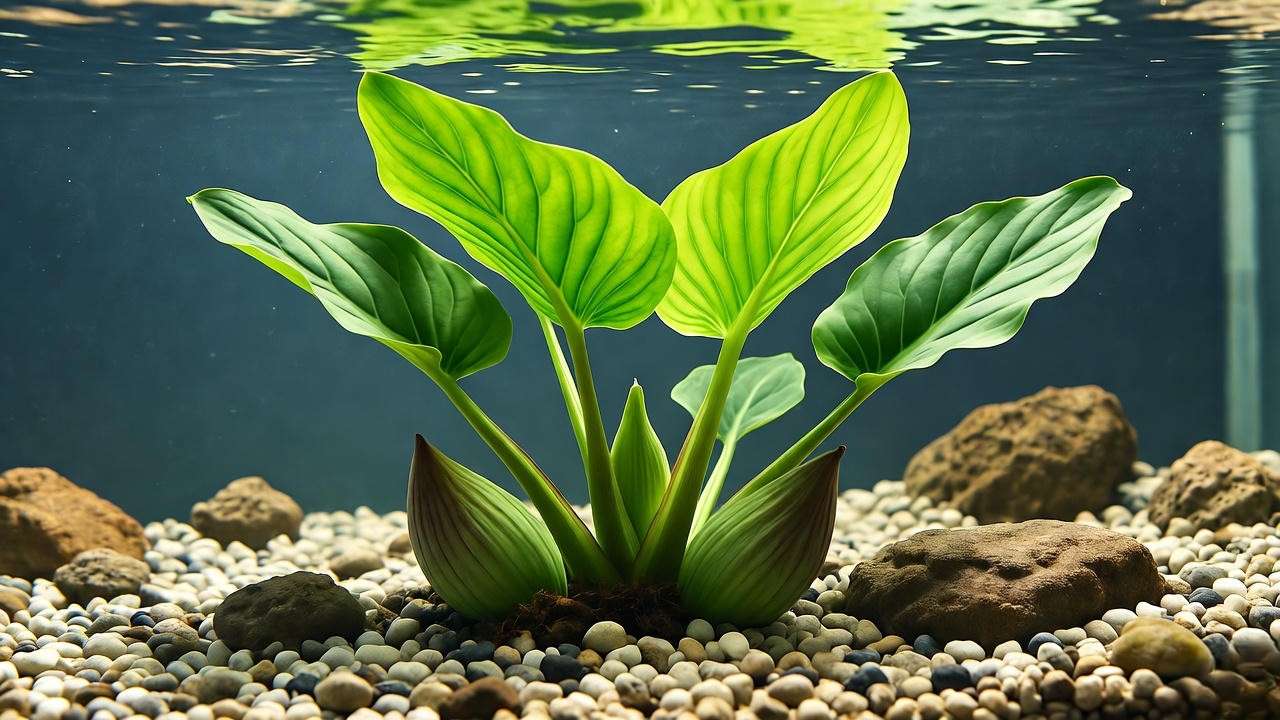
Water and Nutrient Requirements
Banana plants are nutrient-hungry, so supplementation is key:
- Fertilization: Use liquid fertilizers (e.g., Seachem Flourish) every 2–3 weeks or root tabs placed near the tubers monthly.
- CO2 Supplementation: While not mandatory, adding CO2 (via liquid CO2 boosters or injection systems) promotes lush, vibrant growth.
- Water Changes: Perform 20–30% water changes weekly to maintain stable parameters and prevent nutrient buildup.
Test water regularly with a reliable aquarium test kit to ensure pH, hardness, and nitrate levels stay within the ideal range.
Pruning and Maintenance
Regular maintenance keeps your banana plant healthy and your aquarium tidy:
- Trimming: Use aquascaping scissors to remove yellowing or dead leaves at the base, avoiding damage to healthy stems.
- Controlling Runners: Banana plants produce runners (long stems with plantlets). Trim these if they overcrowd the tank, or propagate them (see below).
- Algae Removal: Gently wipe leaves with a soft cloth or use algae-eating species like nerite snails to keep foliage clean.
Pro Insight: Apply a low-dose liquid fertilizer every two weeks for vibrant, sustained growth. Avoid over-fertilizing, as it can fuel algae blooms. 💧
Common Challenges and How to Solve Them ⚠️
Yellowing Leaves or Stunted Growth
Yellowing leaves or slow growth can be disheartening, but these issues are often easy to fix. Common causes include:
- Nutrient Deficiency: Lack of essential nutrients like nitrogen, potassium, or iron.
- Inadequate Lighting: Too little light hinders photosynthesis.
- Incorrect Water Parameters: pH or temperature outside the ideal range (70–82°F, pH 6.0–7.5).
Solutions:
- Test water parameters with a reliable kit and adjust as needed.
- Increase lighting to 1.5–2 watts per gallon or use a full-spectrum LED.
- Supplement with liquid fertilizers or root tabs to address nutrient deficiencies.
Regular monitoring and small adjustments can restore your plant’s vibrancy within 1–2 weeks.
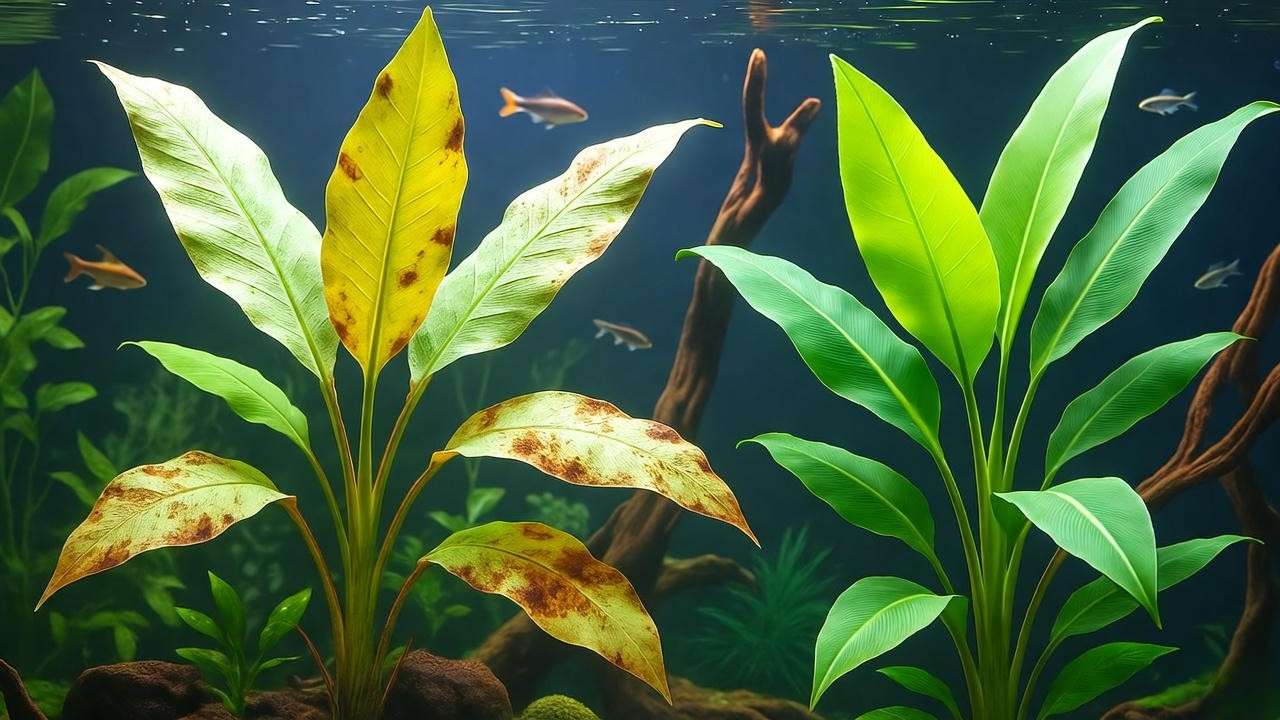
Algae Overgrowth on Banana Plants
Algae on banana plant leaves can detract from their beauty. This issue often stems from:
- Excessive Light: Lighting periods longer than 10 hours or too-intense bulbs.
- Nutrient Imbalance: High nitrate or phosphate levels from overfeeding or infrequent water changes.
Solutions:
- Reduce lighting to 8–10 hours daily and consider a timer for consistency.
- Perform 20–30% water changes weekly to control nutrient levels.
- Introduce algae-eating tank mates like Siamese algae eaters, nerite snails, or Amano shrimp.
Gently clean leaves with a soft cloth during maintenance to prevent algae buildup without damaging the plant.
Floating Tubers or Uprooting
If your banana plant’s tubers keep floating or the plant uproots, the issue may be:
- Improper Planting: Tubers buried too shallowly or in loose substrate.
- Strong Water Flow: Powerful filters or pumps dislodging the plant.
Fixes:
- Replant tubers, ensuring they’re anchored in 1–2 inches of nutrient-rich substrate, with the top third exposed.
- Use small, aquarium-safe pebbles or plant weights to secure tubers until roots develop.
- Adjust filter output to create gentle water flow or add a sponge filter for sensitive setups.
Troubleshooting Table:
| Issue | Cause | Solution |
|---|---|---|
| Yellow leaves | Low nutrients | Add root tabs or liquid fertilizer |
| Algae buildup | Excess light | Shorten light exposure to 8–10 hours |
| Floating tubers | Loose substrate | Anchor with pebbles or weights |
Compatibility with Fish and Other Plants 🐠🌿
Best Tank Mates for Banana Plants
Banana plants create a harmonious environment for many aquarium inhabitants. Ideal tank mates include:
- Betta Fish: Their love for shaded, calm areas aligns perfectly with banana plant foliage.
- Tetras: Neon or cardinal tetras thrive in the plant’s shelter and add vibrant color.
- Guppies: These hardy fish enjoy the hiding spots provided by broad leaves.
- Shrimp: Cherry shrimp or Amano shrimp graze on algae without harming the plant.
Avoid herbivorous fish like goldfish, silver dollars, or certain cichlids, as they may nibble on leaves, damaging the plant. Banana plants also benefit fish by improving water quality and reducing stress through natural cover.
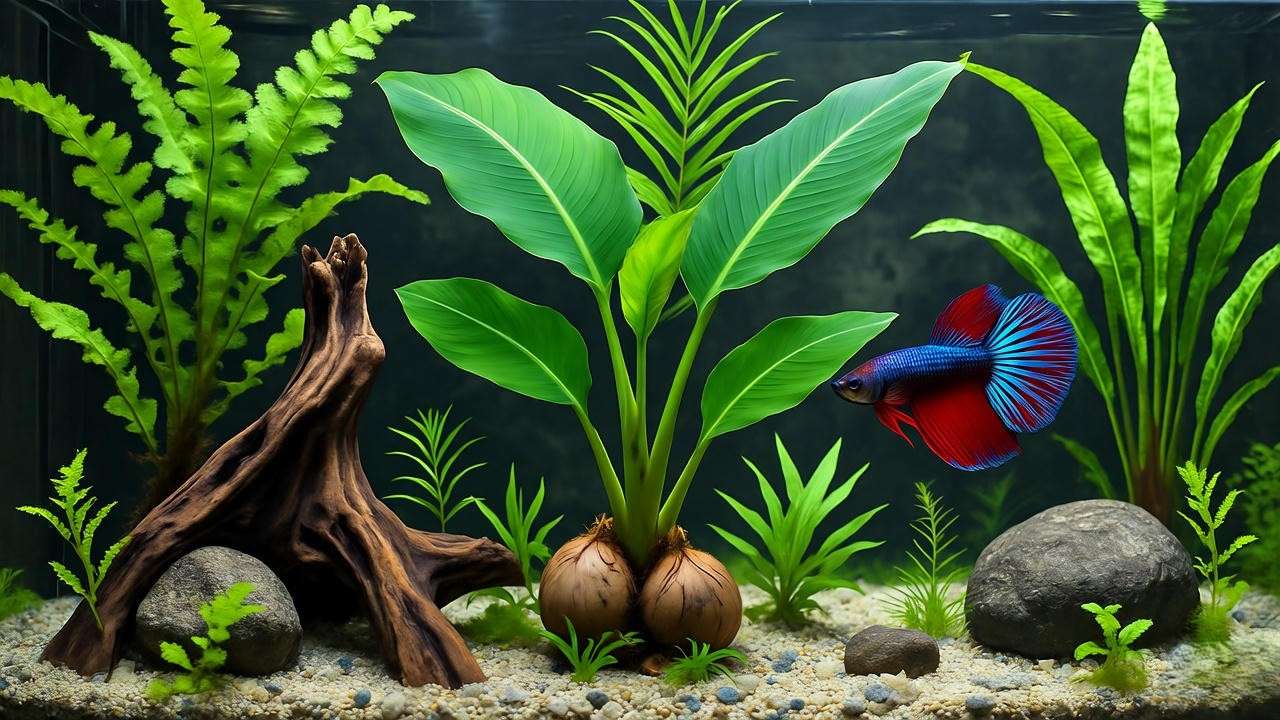
Pairing with Other Aquatic Plants
For a balanced aquascape, pair banana plants with complementary aquatic species:
- Anubias: Low-light, slow-growing plants that thrive in similar conditions.
- Java Fern: Adds texture and pairs well with banana plants’ lush foliage.
- Amazon Sword: Creates a dramatic backdrop in larger tanks.
- Place banana plants in the midground or foreground to highlight their unique tubers.
- Use taller plants like Amazon swords in the background for depth.
- Ensure sufficient nutrients (e.g., root tabs) to prevent competition between plants.
Avoid overcrowding to ensure each plant gets adequate light and nutrients. A well-planned layout enhances both aesthetics and plant health.
Fun Fact: Under optimal conditions, banana plants can produce small, star-shaped white flowers above the water surface, adding a magical touch to your tank! 🌸
Advanced Tips for a Thriving Banana Plant Aquarium 🌟
Propagating Banana Plants
Propagating banana plants is a rewarding way to expand your aquascape or share with fellow hobbyists. Here’s how:
- Identify Runners: Look for long stems with small plantlets growing from the mother plant.
- Cut Carefully: Use aquascaping scissors to snip the runner close to the plantlet, ensuring it has roots or tubers.
- Replant: Plant the new plantlet in nutrient-rich substrate, following the same planting guidelines as above.
- Timing: Propagate during active growth periods (spring or summer) for best results.
New plantlets typically establish within 2–3 weeks. Be patient, as young plants may grow slowly at first.
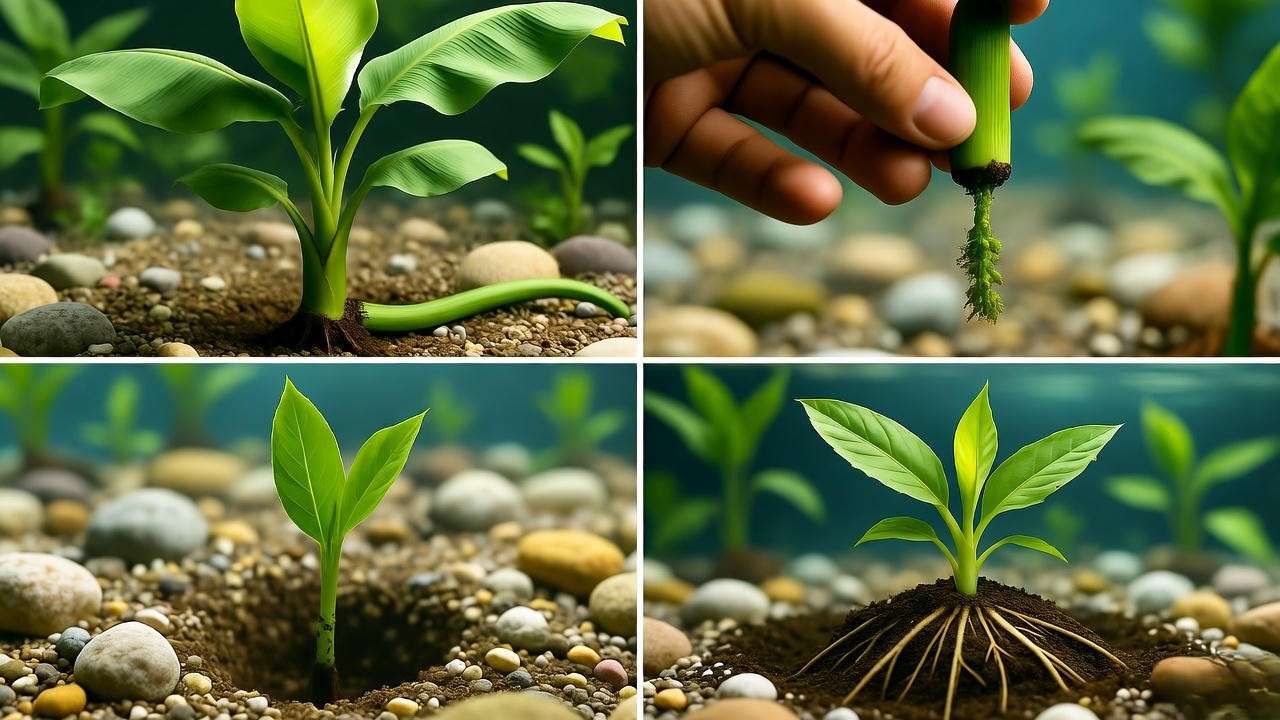
Creating a Show-Stopping Aquascape
Elevate your banana plant aquarium into a visual masterpiece with these advanced tips:
- Centerpiece Design: Use banana plants as a focal point in smaller tanks, surrounded by low-growing plants like dwarf hairgrass.
- Natural Elements: Incorporate driftwood or smooth rocks to mimic a natural wetland habitat.
- Lighting Effects: Use dimmable LED lights to create dynamic lighting, highlighting the plant’s vibrant green leaves.
- Color Contrast: Pair with colorful fish (e.g., neon tetras) or red-stemmed plants like Ludwigia for a striking effect.
Expert Example: In a 20-gallon tank, combine banana plants with Java fern, a piece of driftwood, and a school of neon tetras for a low-maintenance, vibrant display that wows every viewer. 🐟
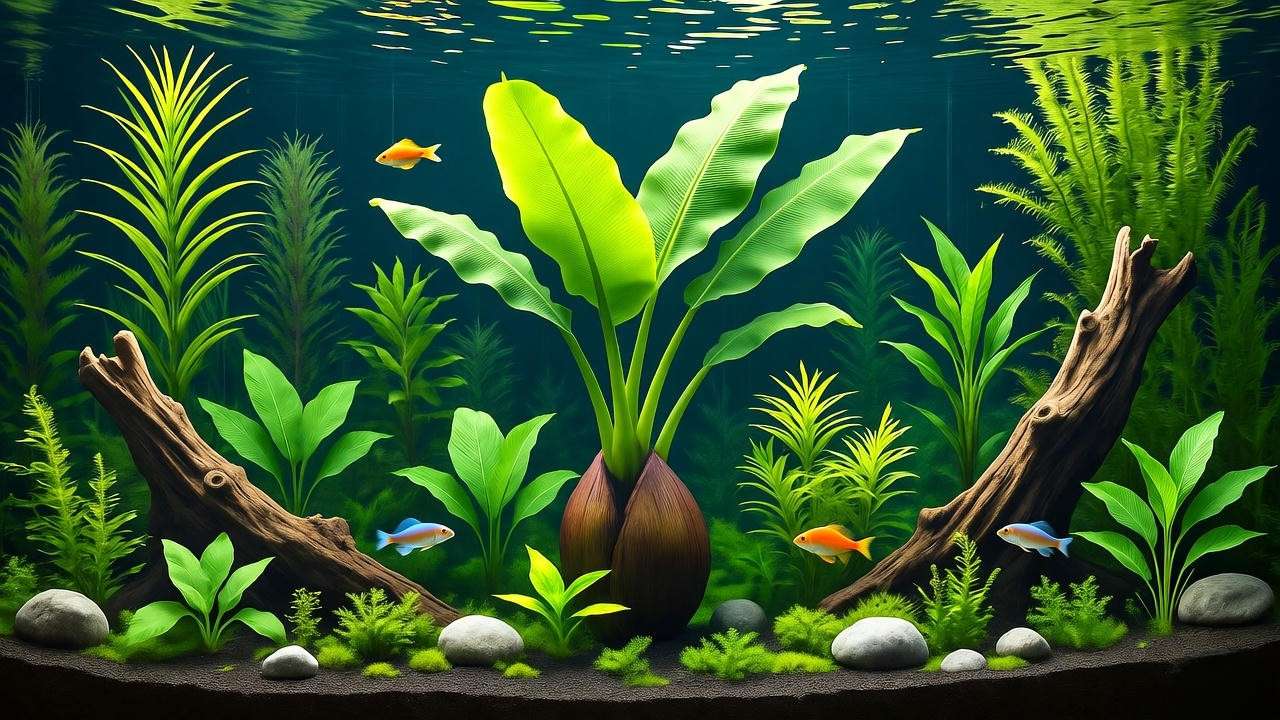
Frequently Asked Questions (FAQs) ❓
- Q: Can banana plants grow in low-light tanks?
A: They can survive in low light but thrive best with moderate to high lighting (1.5–2 watts per gallon). Consider upgrading to a full-spectrum LED for optimal growth. - Q: How fast do banana plants grow?
A: With proper care (adequate light, nutrients, and water conditions), expect noticeable growth within 2–3 weeks, with full establishment in 1–2 months. - Q: Are banana plants safe for all fish?
A: Yes, they’re safe for most fish, but avoid plant-eating species like goldfish or silver dollars, which may damage leaves. - Q: Do banana plants need CO2 injection?
A: CO2 isn’t mandatory, but adding a liquid CO2 booster or injection system can enhance growth and leaf vibrancy.
Conclusion: Your Path to a Lush Banana Plant Aquarium 🌴
Growing a thriving banana plant aquarium is easier than you think! With their unique tubers, lush foliage, and low-maintenance care, banana plants are the perfect way to elevate your tank’s beauty and functionality. By following this guide—choosing the right tank setup, planting correctly, maintaining water quality, and addressing common challenges—you’ll create a stunning underwater jungle that delights both you and your fish. Start your banana plant aquarium journey today, and watch your tank transform into a tropical masterpiece! Share your setup in the comments or explore more aquatic plant care guides on our site for inspiration. 🌿

